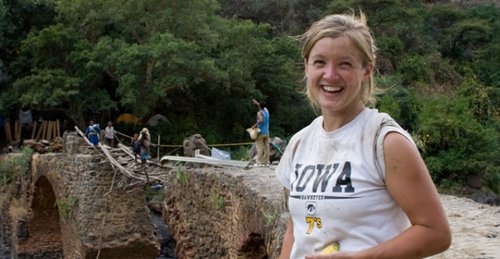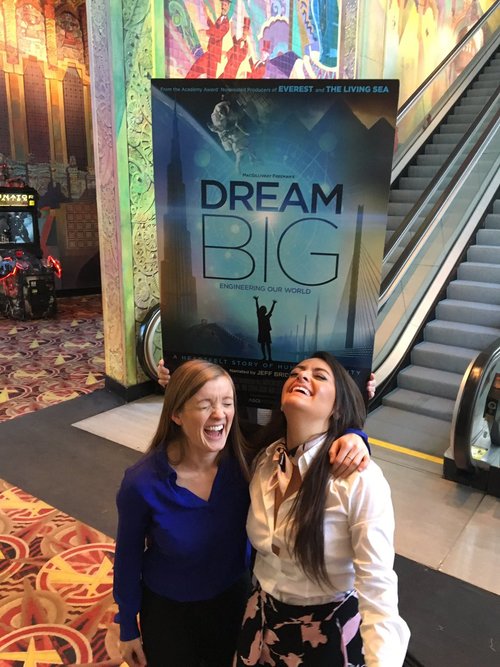

Not many of us ever get the chance to be the face of our chosen profession, much less the face of our generation. But to many, that is exactly what Avery Louise Bang, 32, now represents. And she is making the most of her “15 minutes of fame”, both to benefit her important work, as well as to inspire others. This month, the always sunny CEO of Denver-based Bridges to Prosperity (B2P) began reaching an even broader audience as one of the stars of the spectacular new IMAX film Dream BIG: Engineering Our World, now playing nationally.
After a nine-day whirlwind of jetting to red-carpet premieres in Los Angeles, Denver, Houston, New York, and Washington DC, Avery returned to England this week to resume her MBA pursuits at the University of Oxford. There, on sabbatical from B2P for a year, she is studying how best “to use business acumen to enact social change.” Toward that end, Avery already is managing director of the Oxford Seed Fund, the storied school’s first student-led effort to invest in early-stage ventures. So, understandably, BuiltWorlds felt fortunate this week to catch up with her for quick interview.
BW: Thanks so much. This seems like a ridiculously busy time, even for you. But you have been honored in the past by ASCE, ENR, USGBC, even the UN. And you’ve given multiple TEDx Talks, and conference keynotes. Aren’t engineers introverts? How do you do it all?
Avery: Well, first let me say that I’m normally a pretty active person, but even for me, this last week or two has really stretched me, just about to the limit. The premieres were really fun and amazing, though, and I see this aspect of it all as really a passion point. One of the most important things for me to do, as an engineer and as a woman, is just to get out there, and to be visible. For young girls, you can’t be what you can’t see. So I feel like it’s almost our obligation just to get out there and be seen.
BW: So, what you drew you into engineering? And then, what led you into this particular area of the profession, where you could use those skills to help others?
Avery: My dad was an engineer, and growing up, he would often take me along on bridge inspections. Or sometimes, we would just stop and get out of our car to go look underneath structures. So, I always saw what he did — civil engineering — as a heroic career choice. But I don’t really think that my “aha moment” came until my senior year at University of Iowa. I took some time off and bought a one-way ticket to Fiji, really to get outside my comfort zone. I’d been a varsity soccer player, but I knew that there was more to life than kicking a ball. In Fiji, when I discovered how kids there needed a footbridge just to have safe access to school, that really hit me. When I realized that something so simple could make such a big difference, I knew that that’s what I wanted to do. It married my right brain to my left brain.
- Revisit a BW exclusive from 2014, written by B2P Rwanda project manager Andrew Seelaus, P.E.
- Below, an interview from last summer, conducted by the University of Colorado at Boulder.
BW: How did that epiphany lead you to Bridges to Prosperity?
Avery: When I got back to the States, I immediately started researching who, if anybody, did that sort of work. Who provided simple access to peoples in remote areas of the world? I eventually found this group in Virginia, Bridges to Prosperity, who did just that. They’d been founded by engineer Ken Frantz and were funded by Rotary International, in which he was a member. It took me three phone calls to finally convince Ken that I wasn’t just some excited college kid, that I was serious about signing on. Back at school, I even built my masters thesis around how to grow B2P, and why they should hire me.
BW: Well, that obviously worked. How does B2P’s impact now compare to those early years?
Avery: When I started, we built two to three footbridges per year and had an annual budget of about $120,000. Today, we have 43 bridges under construction in 18 different countries, 50 full-time employees and an annual budget of just under $4 million. And we have relationships now with many universities and engineering schools, and several large engineering and construction firms. That was the goal of the corporate partnership program that I’d created for B2P’s strategic development.
BW: Those corporate partners today include an impressive list of 22 firms, including Flatiron, CH2M, Parsons, Arup, Buro Happold, Kiewit, Hochtief, Walsh, Bechtel, and PCL, plus the Thornton Tomasetti Foundation. Most have a global footprint, with employees from all over the world who volunteer for B2P. How has the new U.S. policy toward immigration affected such an international organization? I see that you recently joined an open letter signed by over 400 other social entrepreneurs about the policy shift. Do you anticipate that B2P’s work will be affected in the coming year?
Avery: Well, firms we work with fall on all sides of this issue, so we are really not trying to be political. But when you have students and engineers traveling from all over, you don’t want uncertainty. So that is what is really the source of our concern. We need clarity. So I really think we are in a ‘wait and see’ period now. Of course, I could dive into other issues on this topic, but this really isn’t the place for that.
BW: Fair enough. Now, the career path you have chosen is clearly a ‘calling’. But such work can easily consume your life if you let it. I recently saw an interview with you where you said that fear of footbridges failing somewhere in the world was enough to keep you up at night. So, given that 24/7 concern, how do you avoid ‘burnout’ in yourself, and in the B2P employees you hire?
Avery: If you work all the time, that is just not sustainable. So we emphasize to our employees that they need to prioritize. They need to take care of themselves, and to separate their life from their job. It’s not always easy, but maintaining that separation is very important to us.
BW: And with that, we’ll let you get back to your life. Avery, thank you so much for your time.
Avery: Happy to chat. Thank you for this opportunity.


Discussion
Be the first to leave a comment.
You must be a member of the BuiltWorlds community to join the discussion.